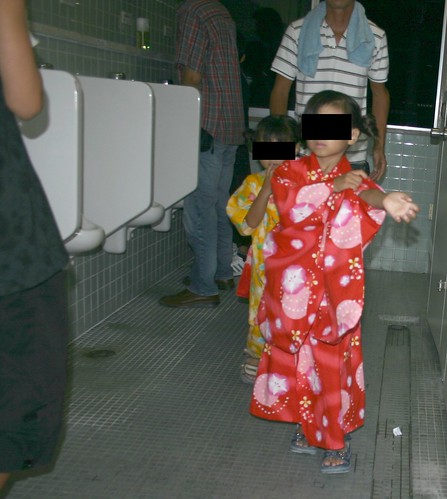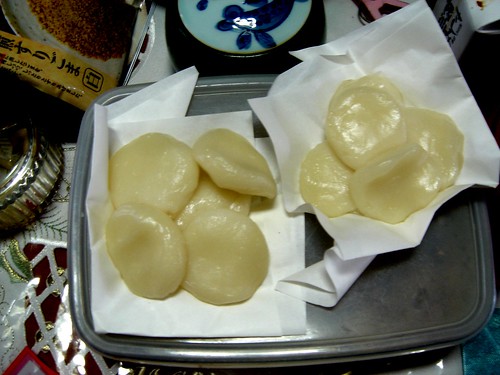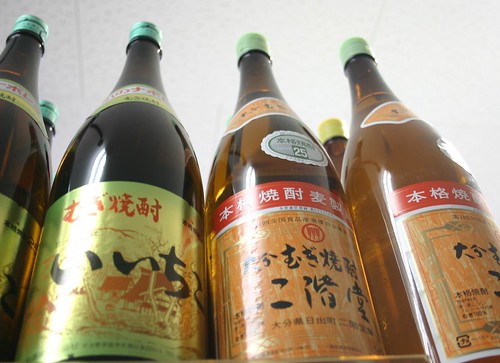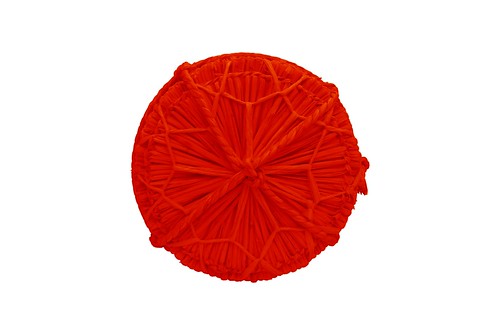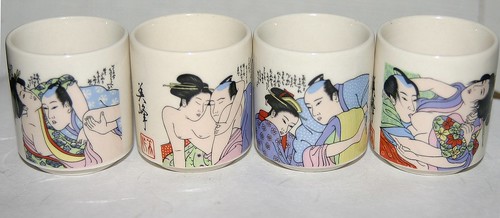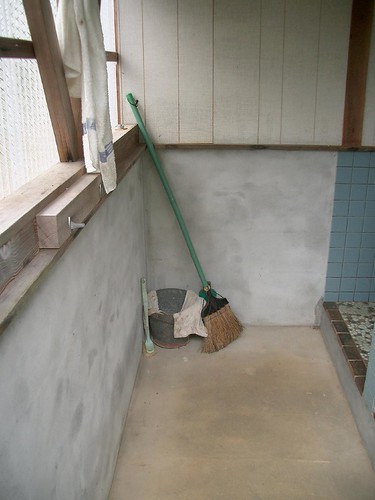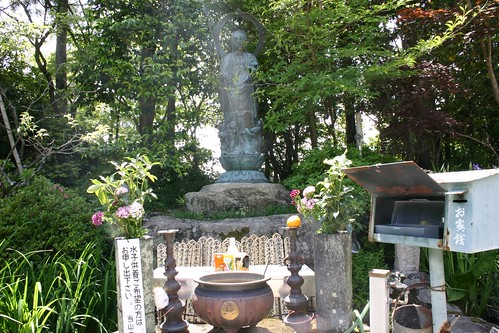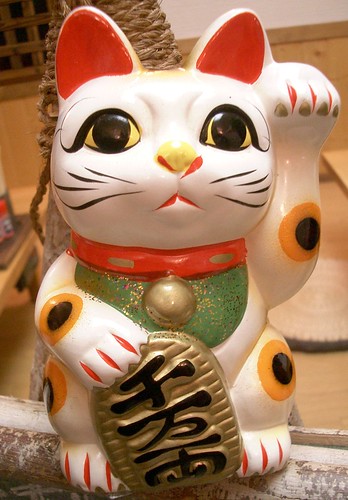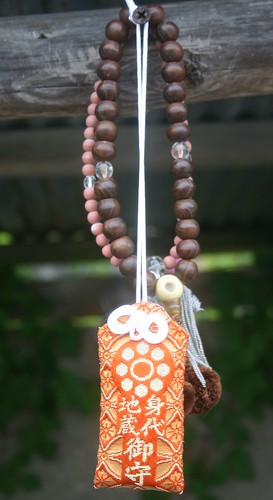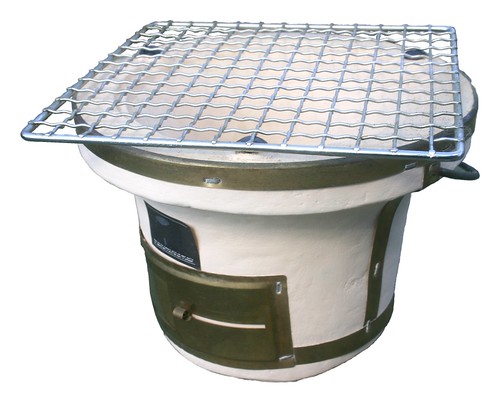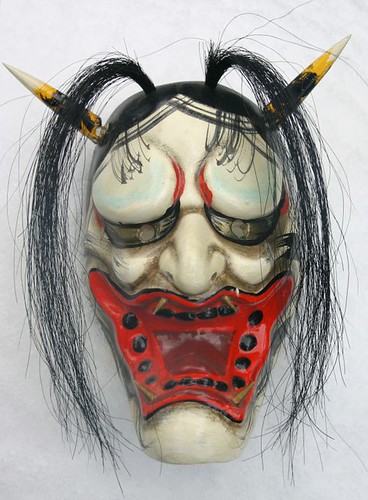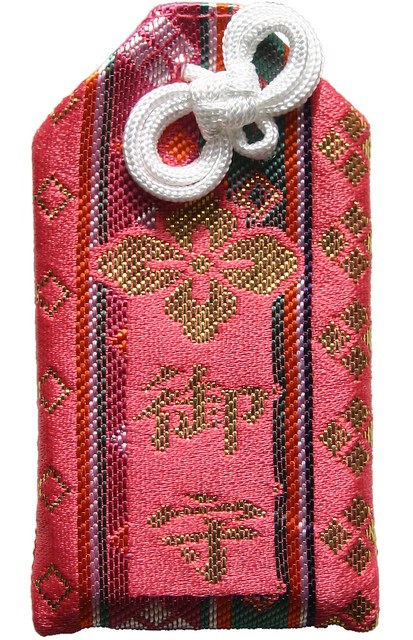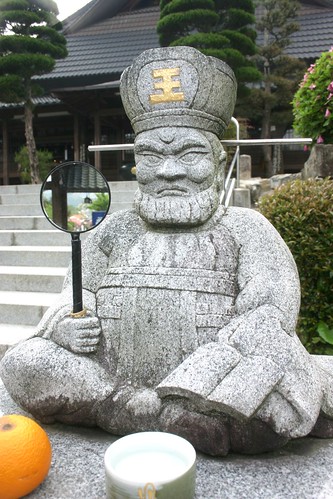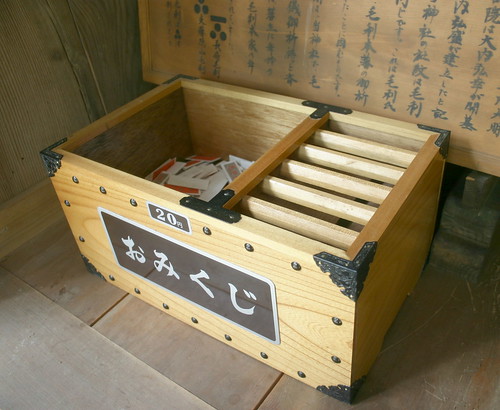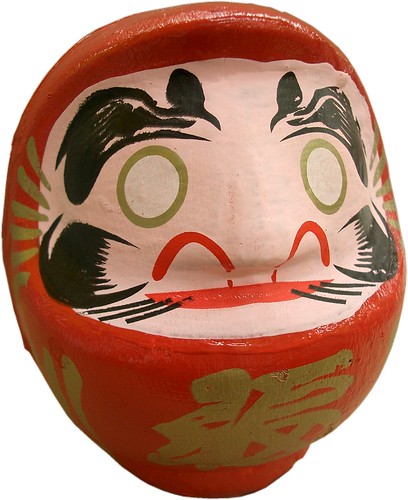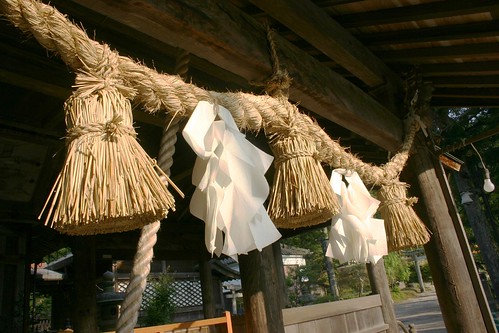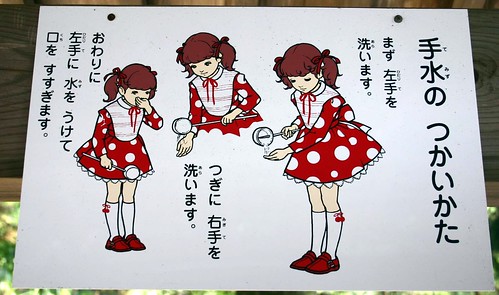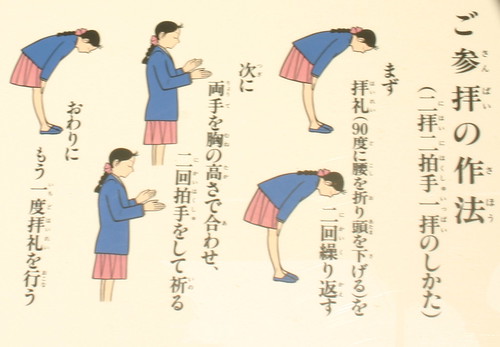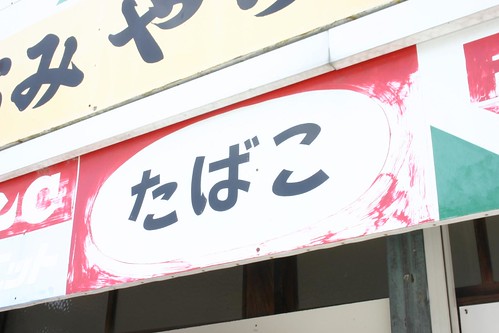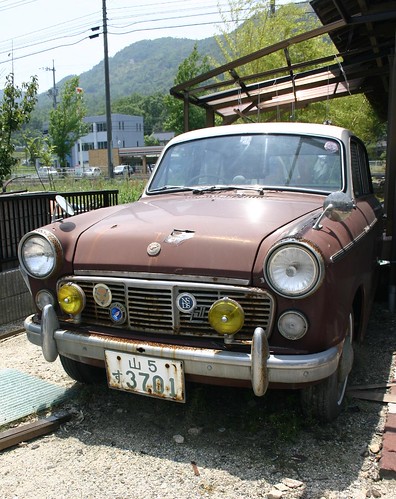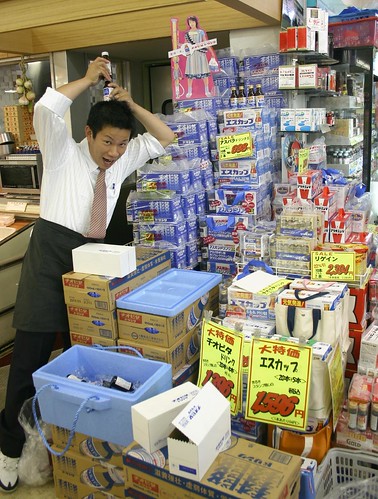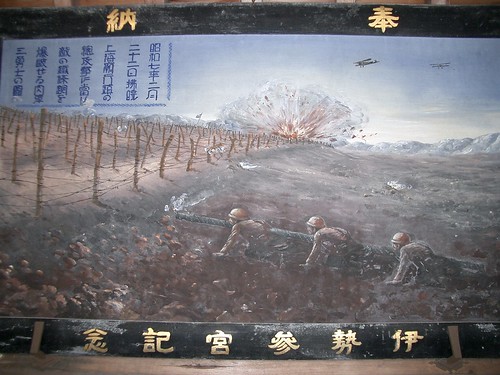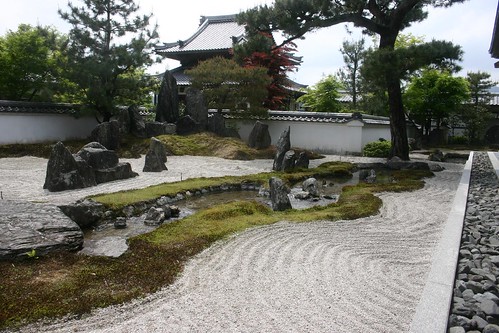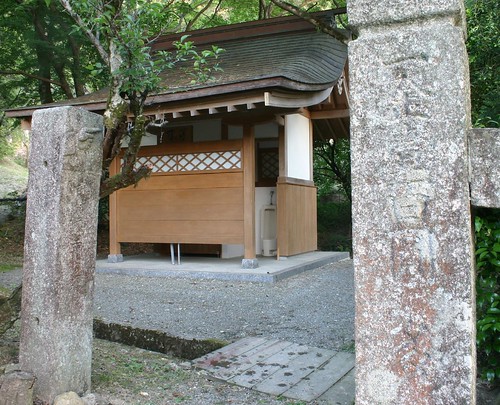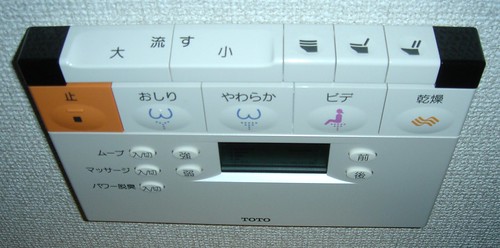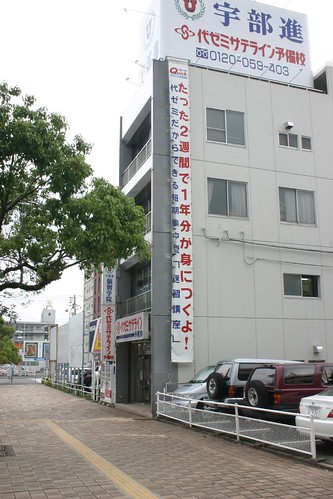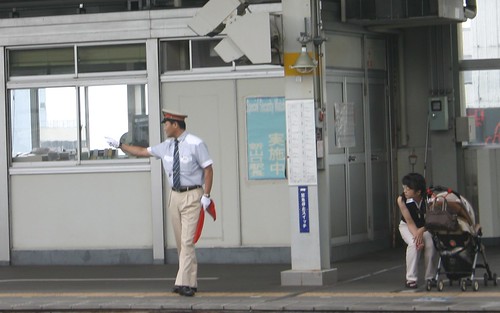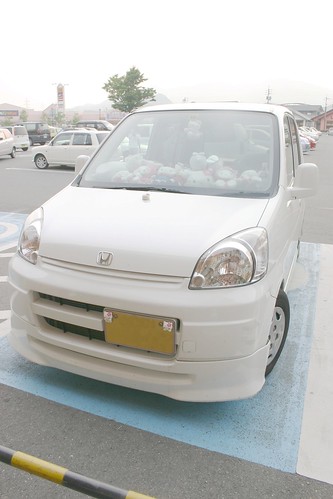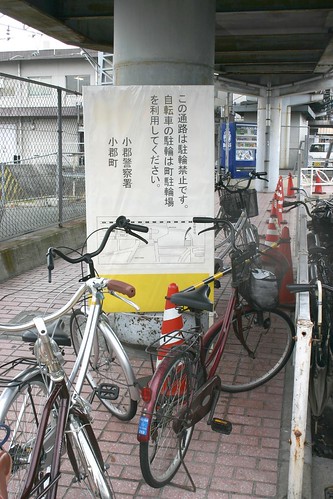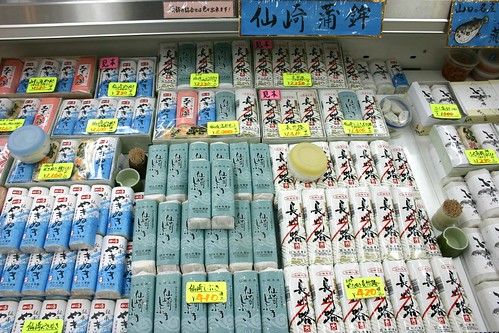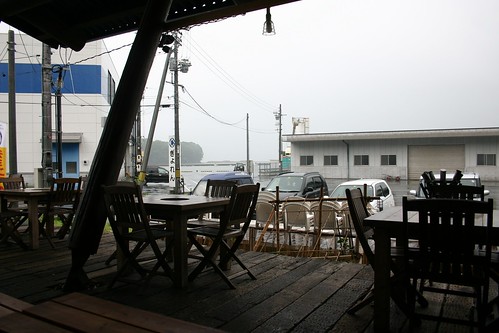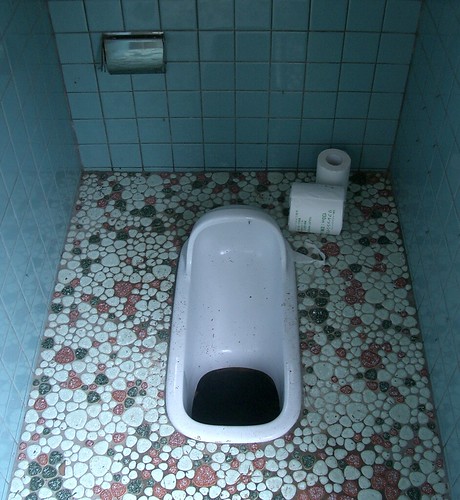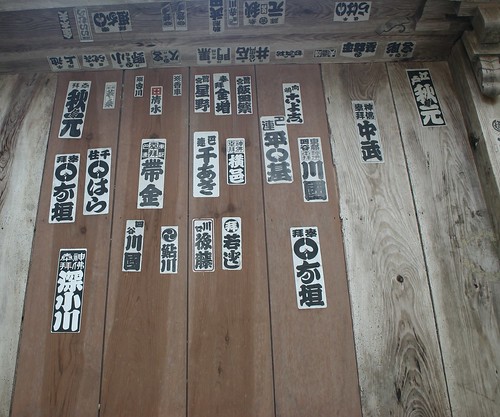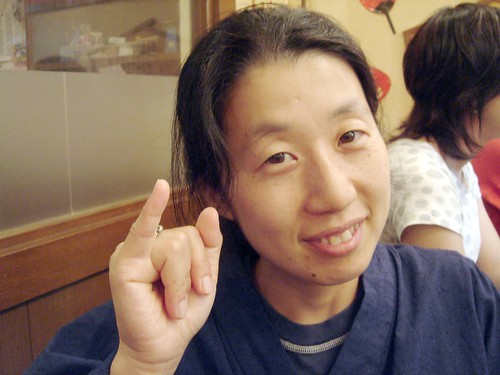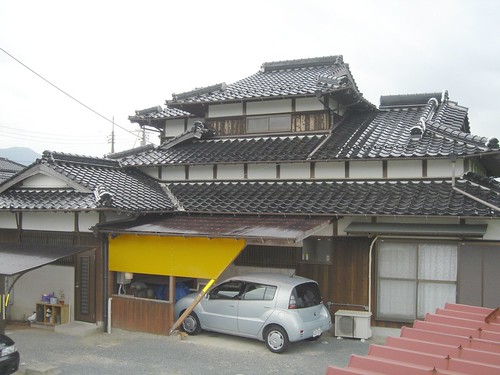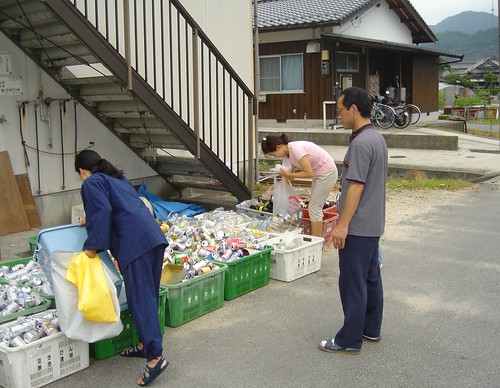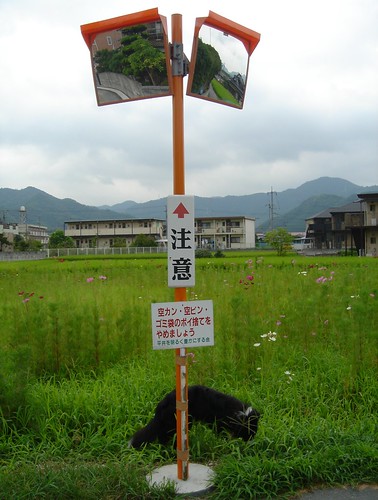Wednesday, August 17, 2005
Blonde Japanese Dolls
Labels: japan, japanese culture, nihonbunka, westernisation, 日本文化
Little Girl in Gents
A little girl leaves a stall of the men's and passes behind the men's urinals, rolling up her sleeves perhaps in preparation for washing her hands. I am not sure why she did not go to the women's. She seems big enough to go on her own. Perhaps she needed help with here summer cotton kimono? I don't think that she would be allowed in the gentlemen's' toilet in the UK. The men's toilets smell but they are not a terribly taboo place, here in the land of the naked men.
Labels: japan, japanese culture, nihonbunka, sex, 日本文化
Welcoming Rice Cakes Mukaedango
These "welcoming rice cakes" (Mukaedango) are put out at the beginning of the summer festival to welcome the return of the spirits of the ancestors to the family home.
According to the ethnologist Yanagita Kuniyo, the Obon festival is one of two times of the year when the spirits come to the home, the other being the New Years festival. The symmetry between the two festivals, at the festival for the ancestors (obon) in Summer and the New Year Festival (shougatsu), is visible in the details, in the fact for instance that round rice cakes are put out on display.
In my own opinion, I see obon as a Shinto, or Shinto-Buddhist festival.
Labels: japan, japanese culture, nihonbunka, 日本文化
Big Sake (Shouchuu)
This is not sake but "shouchuu" Japanese vodka, made from potatoes, wheat, or rice and distilled to a fairly potent 25 percent alcohol by volume. It is rumoured not to give the drinker much of a hangover due to its purity. It is drunk straight, with ice, or with hot water (for maximum effect).
The Japanese are not ashamed to say that they drink alcohol for its effect. The bottles are big, and the consumption among middle aged men appears to be quite high.
The brand names and logos of the products in the photograph are copyright their respective manufacturers.
Labels: japan, japanese culture, nihonbunka, 日本文化
Japanese Flag Made of Rice Barrel
Labels: japan, japanese culture, nihonbunka, 日本文化
Japanese Saw
Labels: japan, japanese culture, nihonbunka, 日本文化
Erotic Cups
Labels: japan, japanese culture, nihonbunka, sex, 日本文化
Big Car Cheap
Large second hand cars in Japan are cheap. This Nissan Gloria had 80,000 kilometers on the clock and should run for as much again but it has a price tag of a mere 1500 USD.
The Japanese are very environmentally conscious in some ways. There is a lot of recycling, use of renewable sources of energy such as wind and solar power, investment in energy saving technology such as hybrid cards, very economical cars, use of traditional energy saving devices such as heated coffee tables, bed warmers, and taps that allow one to wash ones hands with the water that fills the toilet cistern. But one area in which the Japanese do not excel is that of using second hand products.
Second hand products are seeing a considerable increase in popularity at the moment, but until a few years ago there were very few second hand clothes and appliance stores. The prices of second hand cars was low. And the "large rubbish" days when Japanese threw away television sets, bicycles and other items that might otherwise find their way to a second hand store were a bonanza of perfectly usable stuff but those that carted it away were often gaijin.
The Japanese seem to feel that second hand goods are in some sense dirty and thus defiled. Perhaps it is the shinto influence. I wonder if Shinto shrines could team up with second hand stores to offer purified (oharai sumi) second hand goods.
Labels: japan, japanese culture, nihonbunka, 日本文化
Model Food
For my explanation of the philosophy behind model food, please see this post on model ice cream
Labels: japan, japanese culture, nihonbunka, 日本文化
In Britain they would be Stolen
For example it used to amaze me how Japanese can leave cleaning products in public places, such as in the public toilet above, and that no one steals them. The bucket, broom and cloth toilet brush and bleach are perhaps too old and dirty for even Britons to whish to steal them, but placed as they are in an unlocked and isolated public toilet, I predict that they would not long remain intact in the UK. If things are not locked up or nailed down, then they are either stolen, or if they are of little use then they would be destroyed, destroyed. In the UK, if no one was interested in stealing the broom then someone would probably use it to beat in the windows of the toilet, then break it in half and then throw it into the bushes.
Cleaning products and utensils for cleaning such as these can be seen left in toilets, shrines, parks and even bus stops.
But there are some crimes that the Japanese seem to be into such as pork barrelling, confidence trickery, "dangou" cartells, reading books before purchase, and speed limits are liberally interpretted, as are of occasion are the constitution, international treaties, and marriage vows.
All the same though, I generally believe in the moral superiority of the Japanese!
Labels: japan, japanese culture, nihonbunka, 日本文化
Buddhist Altar to Aborted and Misscarried Children
Labels: japan, japanese culture, nihonbunka, 日本文化
Inviting Cat (Maneki Neko)
Labels: japan, japanese culture, nihonbunka, 日本文化
Talisman and Prayer Beads
I have a theory that Joudou ShinShuu or "Pure Land" Buddhism may be based upon Catholicism. Or, if not actually based upon Catholicism in inception, taps a similar religious sentiment, and when Catholicism was outlawed in Japan, may have been the religion of choice for those that would otherwise worship Christianity.
Joudoushinshu
1) Simple prayer for any time or occasion
2) "Other power" Buddhism - it is only by worship that humans can reach the Buddha
3) The vow of the Amida Buddha is to bear our sins and lead all into enlightenment.
4) Enlightenment happens post death - those that believe in the Amida Buddha are reborn in the "pure land" (which is in the West!)
5) It is especially for sinners - even the bad can reach enlightenment if they believe in and worship the Amida Buddha.
Interesting difference - The Amida Buddha is neither male nor female.
Labels: japan, japanese culture, nihonbunka, 日本文化
Suicide Barbeque
Labels: japan, japanese culture, nihonbunka, 日本文化
Hanya in the Snow
Talisman/Omamori/Good Luck Charm
In Japan the lucky charms called "Omamori," (literally "protectors") are said to work by being a decoy-self ("migawari) that attracts bad luck.
Hence any "impurity" or bad luck is collected in the charm instead of in the person. The charm is thrown away once a year, together with the bad luck.
There is quite a lot of theory behind this.
Omamori are basically very similar to the larger tablets bearing the name of the deity "ofuda" that one receives from a Shinto shrine. These larger tablets are enshrined within the home on the Spirit Shelf (Kamidana). Omamori are also basically pieces of paper stamped with the name of the god.
Why should a piece of paper stamped with the name of the god be a decoy-self?
The easiest way to answer this question is by referring to Japanese Buddhism. Japanese Buddhism concentrates on rituals for the dead. The dead are enshrined in the household inside the "butsudan" or buddha cupboard. Inside the buddha cupboard there is an effigy of the buddha, but perhaps more importantly there are a lot of little tablets (called ihai) which represent one's dead relatives. People open the butsudan and say "hello grandpa" to their grandfather in the form of his little tablet.
According to the Japanese ethnologist Yanagita Kunio, the Budda cupboard (Butsudan) and the Spirit Shelf (Kamidana). The spirit shelf was for the living and the bustudan was for the dead but basically in both there was a deity (Shinto Kami or spirit, or Buddhist buddha) and in both there was representations of members of the household, living or dead.
Today in Japan there are few personal tablets for the living (other than omamori) but there are traditions of sticking the names of the living onto the shrine shelf in some parts of Japan. In the past, people recieved a part of the spirit of their local shrine and this in a sense gave them life. In other words a ticket or tag from the shrine represented a person.
This is why a "omamori" is a bit like a spare ID card. If you have some bad luck, like being caught doing a minor misdemeanour then you charge it, or put it down to the spare id, which you throw away at the end of the year.
The new year is said to be a rebirth, everyone gets a new identity. Everyone starts afresh with a clean slate.
Labels: japan, japanese culture, nihonbunka, 日本文化
Shinto Saint Peter of the Pearly Gates
This picture is very much in line with my theory of the Japanese self being "in the mirror."
Labels: japan, japanese culture, nihonbunka, 日本文化
Fortunes Omikuji
Fortunes work, I believe, since either they are sufficiently vague for us to interpret them according to the desires and predictions of our subconscious, or when they really do not fit, our subconscious tells us that they do not fit. So fortunes give voice to the subconscious. And perhaps the subconscious is the spirit.
Labels: japan, japanese culture, nihonbunka, 日本文化
Blind Daruma Buddha
Labels: japan, japanese culture, nihonbunka, 日本文化
Shrine Rope
Labels: japan, japanese culture, nihonbunka, 日本文化
How to Wash your Hands and House
The instructions read:
How to use the sacred washbasin (temizu - literally "hand water")
1) First wash your left hand.
2) Then wash your right hand.
3) Finally cup some water in your left hand and use it to rinse out your mouth.
The right hand was considered to be more impure than the left, hence the use of ones left hand as a cup.
It is traditional to wash ones hands before praying at a Shinto shrine where purity and cleanliness is considered to be of utmost importance. Students from the Kokugakuin University which has a department to train shrine priests also left a little bit of water in the ladle and by tipping the ladle upwards arranged for this final egg-cup-full of water to run down the handle of the ladle, thus washing it for the next user. This page at the website of Tsukubayama Shrine explains the hand washing (and Shinto prayer) process in full, and also recommends that one bow at the "sacred washbasin" before and after washing ones hands. In Shinto, being animistic, one expresses ones gratitude to everything including washbasin.
Japanese would traditionally wash their hands before praying at a shrine and clean their whole house at the end of the year (oo-souji, or "the big cleaning") in a winter equivalent of a "spring clean." It was traditional in Tokyo at least to replace the "goza," smooth woven covering of tatami mats and add a new layer of Japanese paper on internal sliding screen doors. If you carry out this sort of spring clean, as I have done, the New Year can feel like a rebirth, as it is claimed to be.
Labels: japan, japanese culture, nihonbunka, Shinto, 日本文化
Instructions on How to Pray
Please click the photograph to see explanations of the meaning.
Labels: japan, japanese culture, nihonbunka, 日本文化
Hidden Loanword
Tabako was taken from Dutch apparently, and has been in the Japanese language for so long that it is considered to be a Japanese word.
I can't think of any other hidden loan words (もぐり外来語) can you? I was thinking of words like banana or kyabetsu but they are all written in Katakana too.
The word for "name" has a tremendous amount of similarity in many languages in the world, but this site site that the Japanese "na" is from "ne" or sound.
gogen-allguide.com/na/namae.html
Aha, the author of the above referenced site says that there are quite a few words such as "karuta," from the Portuguese "carta" and "tempura," from the Portuguese "tempero".
There will be an article, in Japanese, on this issue at the "Gogeyuraijiten" (dictionary of etymological origins) soon.
Labels: japan, japanese culture, nihonbunka, 日本文化
Whale Meat Poster
A poster explaining the parts of the whale used in cooking. I include these photographs since whale meat eating is somewhat controversial, and I think that I used to be opposed to it myself.
Whale used to be very common. I think that people came to recognize it as being both 'traditional' (in the sense of something that defines Japanese culture) and 'popular' (enough to be on sale at a souvenir shop) as a result of the ban on whales.
Now we know just how popular it is because we know the Japanese whale 'research' fishing quota which is about 500 mink whales a year. People crave for it because it is difficult to get their hands on it.
A lot of people in Japan are upset about the whaling ban. I think that their opinion is:
1) It is Western nations that are trying to enforce the ban.
2) It is (they claim) Western nations that over fished whales using whales for soap etc, whereas Japan just wants to eat them (they say)
3) Westerners are big meat eaters killing loads of innocent creatures, including cows which are quite intelligent, and sheep which are cute enough for Japanese to feel upset about eating.
4) Whales eat a lot of fish, and so by not fishing for whale, the whales endanger fish reserves.
5) Westerners have some sensitivity about eating whale but this is would be like the Japanese insisting that the British do not eat sheep, or that the Japanese do not eat sushi. It is merely the imposition of cultural sensitivities of one nation upon another. (I have a theory that it is the fact that whales form families that makes it difficult for Westerners to eat them.)
6)There is general agreement that endangered species should not be caught and eaten, but there is less agreement about which whales are endangered. Western nations are campaigning a complete ban on whaling. It seems to be clear that several species of whale are far from extinct.
I think that at least (2) above is likely to be counter-factual.
I spent this evening arguing with my wife about the pros and cons of whaling
I said
1) Cannibalism is not something that we accept. It is something that we would like to stamp out. My wife reluctantly agreed.
2) The criterion we use is something like empathy.
3) We feel greater empathy towards whales because
3.1) They are wild animals (as opposed to cattle which depend on us for their existence)
3.2) They have families that approximate to ours, hence we are more likely to feel sympathy towards them.
3.3) They seem to communicate with each other in a deliberate way.
3.4) They are threatened with extinction.
3.5) It is difficult to catch whales without causing the whale prolonged suffering.
My wife responded
1) This anti-whaling thing is cultural imperialism.
2) These western folk that complain do not have their house in order. If they like families so much, then why do they get divorced so often. If they are so into the environment then why don't they separate their rubbish, use less oil, consume less, kill less people with their bombs. They are escaping from their own failings by moaning about the failings of others.
3) Communication takes places between all animals at complex and non conscious levels. What is so special about conscious communication even if whale song conscious? We had quite a long discussion about the merits of conscious and non-conscious communication. I felt that the assertion that 'communication qua communication' (I.e. seemingly deliberate acts of communication that are understood by the sender as well as the receiver) is better than communication as interpretation (such as seeing how often another member of ones species yawns, blushes, farts, or moans) is somehow favouring the male world view. Care-givers such as my wife live in the world of interpretive-communication, and conscious communication is no big deal. The fact that whale seem to indulge in conscious communication is hence no big deal. Whale song (even if conscious communication) And my theoretical defence of whales is basically no different from a belch. It is representative of the fact that I am not satisfied about something, that my guts are not in order.
4) There are people, not whales, that depend upon whaling. What about their livelihood? Humans should be put before whales.
5) Westerners are so arrogant and hypocritical.
6) We eat our whale catch unlike you Westerners that killed whales as a source of oil.
7) What is the big deal about forming families? Birds do too. You Westerners have a monogamy fetish. There are many other criterion by which an animal might be considered special. Salmon migrate. Cows are clever and kept as pets in her town in Kagoshima.
8) It is not as if we want to kill them all off. We just want a few to eat. What is it with you anti-whalers? What about the wars(much greater done by the West), the environmental pollution, the drugs(much greater in the west), the murder(much greater in the west). Get your own house in order.
There are quite a lot of repeats there, but I hope that the (right wing? Japanese pro-whaling) sentiment is a little clearer.
Well...umm...I am not sure. I don't think that I want to eat whale. But I don't think that I want to stop Japanese people from whaling even a little.
Labels: japan, japanese culture, nihonbunka, 日本文化
Early Nissan
I say almost because, Nissan was recently purchased, or part purchased by the French car manufacturer Renault, and this despite the fact that Nissan makes much better cars. Very few Renault cars are sold in Japan, where as Nissan cars are fairly popular in Europe, and have to be limited by "voluntary restrictions". Nissan is good at manufacturing but poor at financial planning. Renault had lots of cash but did not want to invest in its own manufacturing. Hence the Renault investment in Nissan. A marriage made in heaven. As a Brit I only wish that it could have been Austin Rover that had the cash left to purchase Nissan.
Labels: authenticopy, japan, japanese culture, nihonbunka, 日本文化
Health Potions
The Japanese are very keen on these medicines. They are advertised extensively on television and stocked at all chemists and many convenience stores. They contain various minerals and vitamins, extracts such as "royal jelly," and importantly caffeine and nicotine in fairly large quantities. Their effect is largely thus comparable to having two cups of espresso coffee and a cigar. The adverts suggest that drinking these potions makes you "genki hatsu ratsu" (particularly fit in mind and body), keep fighting for one more try, or take off in a personal rocket backpack.
The reason for the Japanese belief in such medicines is probably related to the following:
1) The tradition of imbibing east Asian medicines (Kanpou Yaku) which makes extensive use of various plant and animal extracts and minerals. This tradition continues not only in the health potions featured above but also a general tendency to believe that alcohol, black vinegar, green tea, "green juice" (ao-jiru) vegetable extract, and extracts of certain types of mushrooms have medicinal properties.
2) The Japanese salaried employee is often so busy that he or she has need of drugs such as this to get him (or her) through the day. When I working in a Japanese company employees would bring a case of health potion to the office for everyone to drink.
3) Japan has a culture of linguistic humility where it is considered in bad taste to tell people how much work one is doing. One has to be oblique. But visual signs of endeavour are acceptable, so drinking a health potion at ones desk is a way of telling colleagues that one is trying very hard. Visual expression of "genkiness" and positivity in general are quite acceptable, as can be seen from the photograph above.
4) For Japanese men, machismo is bound up with extent to which they can work hard and long hours. As well as actually facilitating this feat, some health potions accentuate the machismo of the act by having blatantly phallic symbols on the bottle. (Perhaps the samurai hairstyle as being mimicked by the gentleman in his photograph is phallic, as noted elsewhere, the traditional headgear of Shinto priests, the bird hard, is said to be phallic.)
5) As found in Catholic cultures where believers eat the body of God on Sunday, the Japanese have a tradition of consuming food - particularly rice cakes - which is believe to be imbued with the spirit of their deity. The rice cakes consumed at New Year are traditionally believe to have this spiritually invigorating function. (It is also notable that members of Catholic cultures in Europe also seem to be fond of potions too. The French are fond of medicinal teas and the consumption of espresso coffee in both France and Italy seems to have a ritual quality).
Labels: japan, japanese culture, nihonbunka, 日本文化
Mr Poop Candy
The character, Mr. Poop, is well-known and well-liked amoung primary school children. I believe that there is a comic or television catoon depicting the character. The character speaks. He is a pile of poo. It is not clear whose poo.
"Unchi" is the word for faeces used, the etymology of which is the onomatopoeic word for the sound that one makes during a bowel movement "nnn." There is a theory that this originates in the same "nnn" meaning "omega" as spoken by the second of the Koma dogs that guard shrines.
A survey of what British and Japanese students would find difficult to talk about to their parents revealed no great difference in taboo regarding sex, but a considerable difference in taboo regarding faeces. When asked whether they discuss their faeces with their parents a majority of Japanese students said that they did. In the UK this figure was less than 10% and several respondents expressed amazement at the mere suggestion of discussing size or consistency with their parents.
The lack of repression towards faeces can also be observed in the construction of the traditional Japanese toilet where the stool was dropped into a trench, rather than down a hole, perhaps for pre-flush inspection. The squat required to use one of these toilets also ensures a much shorter nose to stool distance.
The origin of the greater degree of familiarity with faeces is perhaps:
1) That faeces were a valuable commodity as manure in Japan until the advent of chemical fertilisers. Unlike the traditional European wheat field, the rice paddy does not need to be rotated with livestock grazing, and application of livestock manure, in order to maintain production of rice. The fermentation process that takes place in the wet field ensures that the field can be used repetitively to produce rice or other grains sometimes twice a year. But some manure is required and, in the absence of livestock, this was provided by using human waste, as well as ash and vegetable peelings. The result of this was that faeces where not thrown away but stored, saved, and prized in rural Japan. Specialist tradesmen would go and buy faeces by the cart load in towns. Another result of the use of human faeces as manure was the prevalence of parasitic worms, and the need for rubber soled shoes.
2) The lack of a strong taboo on nakedness and sex. Perhaps part of the reason why faeces are taboo in the West is due to the proximity of the sex organs to the anus, the drear view Christianity has of the anything below the belt, or even of the body in general.
It should be noted that urination is also not as taboo as in the West, with "standing urination" (tachi-shon) being a common sight even on Tokyo Streets into the 1970's, "group urination" (tsure-shon) being a typical behaviour among young males, and door-less or opened windowed urinals being not uncommon to this day. Attitudes towards urination in Japan will be the subject of a separate post.
The wrapper is copyright of Tomoe Bussan Ltd.
The shape of the poop is similar to that used on posters encouraging dog owners to clean up after their dog.
Labels: japan, japanese culture, nihonbunka, sex, 日本文化
Reading Standing Up
But even in those cases where book stores have signs saying "no reading standing up," the practice seems to be very difficult to prevent. Convenience stores are often lined with high school students reading their way through a manga book or two while waiting for the bus. Bearing in mind that a high school student can read a manga in about 10 to 15 minutes, and each costs about 8 US dollars a copy, this represents a considerable expense.
The same Japanese would not steal a camera if it were left on a park bench, and (like me) may leave the front door of their houses open when they go out. Where I come from you can't leave a car or bicycle unlocked for more than a few minutes before some one will steal it thinking "its asking to be taken," and yet the number of people "stealing a read" is comparatively few.
I think that at the present time Japanese society has generally less thievery of all kinds than the UK. But I find it interesting and notable that the Japanese excel in some areas more than others.
The faces of the people in this photograph have been blurred to disguise their identity even though THEY ARE NOT DOING ANYTHING WRONG.
I repeat that this particularly bookshop did not seem to object to people reading the books at all, so the people in the photograph are not stealing anything.
Labels: japan, japanese culture, nihonbunka, 日本文化
Japanese Soldiers Making the Ultimate Sacrifice
Yosano Akiko's husband wrote a poem about these three heroes who were to become the first war gods (kami) of the Showa era.
Engineers of the 24th Kurume regiment, Eshita Takeji, Kitagawa Susumu* and Sakue Inosuke carried a ignited pipe made of bamboo containing 20 kilograms of explosive into the line of enemy fortifications, and died in the blast. The blast opened a path for the Japanese army to advance.
The event was celebrated by Yosano's poem, Kabuki theatre, cinema and several songs. Three brave soldiers rice cakes" and biscuits were releases and the canteen of an Osaka department store offered Meat Bullet Three Brave warriors food (of unspecified ingredients).
made heroes of the these soldiers over night.
Some claim however that the incident was a mistake owing to the use of a too short, or incorrect fuse, and that soldiers expected to return unharmed but blew up. Other claim that the solders knew the odds that they were facing.
As I heard when living in Kurume, it is also claimed that two of the three were from the Japanese underclass. While living in Kurume I heard the rumour from an ageing gentlemen that those from the Japanese underclass where the first to volunteer for such missions and the first to be asked. But that is only a rumour.
Please see the following Japanese page for details.
drhnakai.hp.infoseek.co.jp/sub1-42.html
The tremendous popularity of this feat is dealt with in Censoring History: Citizenship and Memory in Japan, Germany and the United States where it is suggested, and I agree, that an examination of the media attention surrounding the "meat bullet brave men" allows us to understand just how fervent the war effort in China became. Some recent fiction portrays the Japanese as a land oppressed by militarists that forced the Japanese to participated in an unpopular war.
Engineer Kitagawa's name might also be Tasuku, the character for his name can be can be read in more than one way.
Labels: japan, japanese culture, nihonbunka, 日本文化
Zen Garden
The Zen Garden represents the cosmos I have heard it said. It seems to me that many a Zen garden look like geographies in miniature so that looking at one for a while ones mind starts to play tricks, and the gravel looks like the sea and the rocks like, or patches of grass like islands. The significance of this is, in my opion, like the Kanon bodhisattva statue that appears to be in motion even though it is stationary, to encourage the viewer to realise that scale and motion are in the mind of the beholder. Or that ultimately everything is in the mind of the beholder, and that the data, the pure experience is "mu" (chaos, nothing, Buddha nature) .
禅の庭は宇宙を表しているといわれていると思いますが、自分的に上のような庭はもっと規模の大きい風景を思い浮かばせます。禅の庭をみていると砂利が海にみえたり岩が島に見えたりするという錯覚が生じます。これは動いていないのに、動いているように見える観音菩薩像と同様、規模や動きは見ている人の心の問題であって、知覚されるデータ、その「純粋体験」に内在するものではなく、後者は「無」・「仏心」であることを示しているように思います。
Labels: authenticopy, japan, japanese culture, nihonbunka, 日本文化
Shrine Toilet
As previously mentioned, toilet culture for men at least is quite liberated. Japanese youths are able to tell their parents about their bowel movements. Japanese males were able to pee on the street ("tachi shon") in Tokyo. And young males might invited each other for a pee together ("tsure shon").
But at the same time, Japanese females are these so ashamed of urinating that they would prefer to flush the toilet two or three times during the course of their evacuation rather than let others hear the noise. And as Sleepy days points out there are special electronic devices ("Otohime" or "Sound Princess ") that automatically, or at the touch of a button, emit a noise similar to that of a toilet flushing so that women can rely on the device to obliterate the sound of the tinkle rather than resort to flushing the toilet and wasting all that water. The reasons for this apparent contradiction will become apparent soon, here at burogu.com.
Labels: japan, japanese culture, nihonbunka, 日本文化
New Toilet
Labels: japan, japanese culture, nihonbunka, 日本文化
Cram School or Juku
Such is the competition to get into schools and universities that many teenagers attend a juku or cram school after the end of regular school. There are a lot of reasons for this.
1) The university that one attends largely determines the level of company that one will join and salary that one will receive when one graduates. Companies place great emphasis on obtaining graduates from the best universities.
2) The study that one carries out while at university often makes little difference - neither grade point average nor the level of degree make much difference to companies. The last time that academic achievement matters is at high school level, which fuels the market for cram schools.
3) Japanese schools may fulfil more of a socialising function than those in the UK. Schools, rather than the family, teach young people how to behave in groups. Due to importance of group formation at school, the teaching approximates to the "comprehensive" system in the UK, where better pupils can be held back by their peers. The teacher will be unlikely to move on to the next level. There is rarely streaming by class with rather classes forming close-knit groups.
4) The examinations used by universities are tractable to cramming, often placing an emphasis upon those things that can be learnt by attending a cram school. English exams for instance have traditionally placed an emphasis upon learning grammar structures that are complex even to native speakers rather than upon communicative competence. This is one of the reasons why most Japanese find it very difficult to speak English.
5) The system of fact based exams and cramming is also quite levelling in that the ability to communicate such as by writing essays is one which is predicated more on coming from a household where a lot of communication goes on, often in the more educated, and wealth homes or upon talent. Cramming is something that even the less talented teenager can do if he has the spirit and encouragement to do so. Even if ones father is a taciturn farmer or production worker then one can cram ones way into Tokyo University and the top of Japanese society.
5) Japanese cram schools are very good and very mercenary. A lot of work goes into analysing the entrance exams of the better schools and colleges. A state run school then more attention will be paid to covering the syllabus. The cram schools will concentrate on the content of the exam and the knowledge, tactics and tricks that one needs to pass it.
Labels: japan, japanese culture, nihonbunka, 日本文化
Imitation Church
The company that employs these priests in the Fukuoka Area is however run by fairly serious Christians who insist that the sermon be carried out according to full Christian tradition complete with Christian vows, and readings from the bible. When real churches are used, then real priests often use the opportunity to preach to their heathen audience who otherwise very rarely come to church. For many Japanese, while they enjoy consumerism and a visit to a short stay hotel at Christmas, wedding ceremonies are the only time they enter a church.
This imitation church is an example of an authenticopy, a copy of something that is felt to be quite satisfactory in surving its purpose, and identical in that sense to that which it copies, because it looks like the real thing.
Labels: authenticopy, japan, japanese culture, nihonbunka, 日本文化
Finger Pointing Saftety Checks
As a bullet train (shinkansen) comes in to Shin-Yamaguchi Station, the guard on the platform points at something that needs to be checked, perhaps the fact that there is a train coming.
According to my survey, finger point safety checks do not occur in the UK, the US, Australia and China.
In Japan they are found to decrease the rate of accidents by up to 50% so they are are a duty. The staff take them very seriously, pointing to each of the signs and objects that need to be checked.
In the UK railway system, a similar practice is "calling the road," which refers to saying the colour of each signal and sign as one passes it.
Someone tried to introduce finger pointing safety checks to Australia but the railway staff laughed and refused to take part.
Labels: japan, japanese culture, nihonbunka, 日本文化
Kitty Car
In Japan there is a tremendous taboo upon the sexuality of women. This can be seen in the fact that while men pee on the streets women use "sound princess" devices to hide even the sound of their pee. Or again in the fact that women who express their desire are seen as being monsters, such as Hanya.
As argued by Foucault and others, any desire that is repressed returns in other forms. The more a desire is repressed, the more it comes back in a modified cleansed, neutered way.
While Japanese women are not allowed to give expression to their desire directly, Japanese society is awash with expressions of de-wombed maternal love. Being cute (kawaii) is very positive and important. Perceiving things as cute ("kwaiiiiiii") is likewise positive and important. And surrounding oneself with cute things, such as many "Hello Kitty" cat dolls is likewise a ritual expression of womb based sexuality without the dreaded
The hello kitty characters on the back seat are the size of young children. The numberplate is held on by Hello Kitty headed screws and the water jets for the windscreen are squirted from a Hello Kitty capped nozzle.
Hello Kitty is copyright.
Labels: japan, japanese culture, nihonbunka, 日本文化
Bad Bicyles
Labels: japan, japanese culture, nihonbunka, 日本文化
Do you Prefer to Stand in the Aisle or Sit Next to Fat Gaijin?

This is me on my way to Kyoto. I took this photograph to demonstrate the oft experienced phenomena where I find that there is only one empty seat in a train carriage, next to me, and there are people standing. The effect of this is to make me feel rather lonely and upset, which you may tell from my expression.
I often hear people say that the reason why Japanese do not sit next to me is due to their lack of ability in English. But this does happen when I am reading a Japanese language reading materials (as I usually am when I am on a train).
It also happens to me when I am on seats on subway trains where the seats are at the sides of the train. I have another photograph.
It also happens in lifts, where the shock of seeing a large-male-gaijin in a lift is clear, and has been so great as to encourage people to miss the lift and wait for the next next. (This was a friend of mine who is taller.)
I have also noticed that Japanese women are considerably less inclined to sit next to men, including Japanese men, of my age in general. I personally feel that there is more of a connection between not wanting to sit next to me and not wanting sit next to a middle aged man in general. They are not so scared of inconveniencing me as being inconvenienced themselves.
I think that quite a lot of whites have implicit/subconscious prejudices agains persons of colour, despite their intentions (according to the tests, I have prejudices against whites, despite my intentions).
And in that sense, I think that many whites have an implicit aversions towards sitting next to large black males.
Most prejudice works at a subconscious level. The folks at Harvard have a great programme for demonstrating unconscious prejudices and I am working on a new version that will be able to tell us our prejudices about pretty much anything.
*think,* I am not sure but I think, that the situation in Japan is not all that different to that in the US.
I think that a lot of the reaction has to do with "dread of difference," and that this is what at base motivates both phenomena you mention (personal space and prejudice)
I believe that a lot of whites do feel superior to blacks in terms of morality and intelligence (until the 1950 whites held overt views of this type, and implicit prejudices can be observed from the tests at Harvard University)
However, I think that also Japanese feel superior to whites in morality, cleanliness, and some forms of intelligence (social intelligence) too. (Indeed, I think that I would agree! Oops. No..Whites are nice too!)
As I say, I hope to make the tests to demonstrate Japanese feelings of superiority soon.
However, in both cases I think that these feelings of superiority are fairly insignificant compared to the fear and incomprehension (I think that fear and incomprehension are linked) in the face of that which is different.
We have a gut fear of that which we do not understand. We do not know what aliens will do next. Hence we do not want to work, live, or sit next to them.
While I generally like to come to Japan's defence, I think that whites are not as bad as one may think. White prejudice is pretty much the same as the that felt by the Japanese ladies that do not want to sit next to me.
I think that the feelings of "superiority" are often a secondary reaction in the face of fear. The thought process is:
"Ach, I am scared. But, but, but...I know, I am brainier, better than him."
The feeling of superiority then does go to reinforce the original feeling of fear, and solidify it into mutually reinforcing equations where
The other IS scary/dangerous.
I am better, brainier more moral.
But I think that both start with the fear, and the fear is here, in Japan too.
Labels: japan, japanese culture, nihonbunka, 日本文化
Melon Bread
In my country, the UK, it may well be that even less is respected. The British are fond of making "curry" for instance, and I believe that "curry" is modelled on a Indian subcontinent food, but it neither tastes nor looks like the food upon which it was modelled. British curry looks and tastes like slightly spicy stew.
The interesting difference between Japan and my country is that the Japanese like to make the imported food *look like* the food upon which it was modelled, because the Japanese are occularcentric: in Japan the main thing is vision.
Labels: japan, japanese culture, nihonbunka, 日本文化
Fish Sausage
Labels: japan, japanese culture, nihonbunka, 日本文化
The Japanese are Ambivalent towards Nature
I uploaded this one to illustrate how little the Japanese are into Nature. I know that they worship it but a lot of the time they avoid it or make no effort to experience it.
This is shot from a restaurant of a popular seafood market and mall in Hagi, Yamaguchi. It is called something like "sea market" and it sells all the fruit of the sea (please view my other photos). But for some reason they built the mall/market about 50 yards from the sea, seperated by a warehouse. One can only just see the sea from a gap in the car park. Why didn't they build it on the waterfront so that one could look out accross the choppy sea of Japan while scoffying salmon? Because no one wants to look at the sea. Not even on a nice day. Why is this?
1) The Japanese value convenience more than anything else, and it is more convenient to have the warehouse next to the water's edge, than it is to have a restaurant next to the water's edge.
2) To the Japanese, nature is associated with disaster so they prefer to keep a respectful distance from things thave such awesome power. Indeed, Japanese nature is more inclined to cause both suffering and happiness due to the relative prevalence of earthquakes, tidal waves and hurricanes. Perhaps the positioning of this restaurant is a wise precautionary measure.
3) The Japanese feel themselves to be much more at one with nature as demostnrated by their ability to get their kit off and bathe in the nude with other people, or smell and enjoy their own faeces, or sell and purchase sex services in a manner that would be unacceptable in the UK. Being so much closer to nature the Japanese do not feel the urge to reinforce their link to it. It is rather Westerners that are so used to ignoring or dominating nature that they feel the urge to get on down in amongst it, occasionally, in their spare time.
4) As argued by Rene GIrard or is accessible from psycholanalytic theory, and is apparent from the way that spirit embodiments are hidded and wrapped in Shinto shrines, the sacred is very often taboo. Perhaps the Japanese have an ambivalent unconscious attitude towards nature that encourages them to keep a safe distance. This notion that the negative feelings towards nature are unconscious, and that Japanese people are not even aware of their ambivalence towards nature is born out by the way in which Japanese generally protest that they like nature, and do not seem to realise the lack of restaurants by the sea, or bars by rivers, or places to swim in rivers, or beaches, or paths to the tops of mountains.
5) Japanese women rule Japan and women are generally less interested in nature in both the UK and Japan. If Japanese men were in charge of where restaurants were positioned then they would be positioned on the water's edge as they are in Hawaii or other locations where there are attractive areas of water.
This photo has notes.
Labels: japan, japanese culture, nihonbunka, 日本文化
The End of the World
This, the most infamous of Japanese toilet, is basically a hole in the ground. Can you see the large mosquitoes swarming around the hole waiting to bite bear bottom?
No there are no handles, and yes this is a problem. When there is a flush, sometimes I have grasped the flush pipes to keep myself up and to stand up afterwards but in this flush-free "pot'ton" (the name for this toilet is an onomatopoeic word for the sound that the dump makes as it flies downwards to a landing) variety there is nothing to hold onto at all.
Have you seen an early version of the movie "Mutiny on the Bounty?" The cruel Captain Bligh ordered that drinking water should be available only from a certain spot on the yard arm. All those that could not climb up into the rigging to receive water were deemed not fit to receive sustenance. Many died. Perhaps the Japanese toilet is another evolutionary hurdle. Those that cannot rise from their stool shall be doomed to toiletry oblivion?
All in all it is very harsh. I think that the Japanese must be have been very fit to use them.
I lived in accommodation where this was the only style that there was for a number of years. I had to learn. While I don't particularly like the squat, it seemed sort of healthy, like Yoga crossed with aroma therapy.
The random, non-geometrical nature of the tiling on the floor, may have something in common with the natural, asymmetrical form of the Japanese Garden, as opposed to Geometric Western style garden, as well as facilitating the camouflage soiling on the floor.
Labels: japan, japanese culture, nihonbunka, 日本文化
Senjafuda - One Thousand Shrine Labels
As previously mentioned, this is a form of holy marking - a la graffitti. Some of these may be names, pseudonyms and company or organisation names.
It is traditional to print one thousand of them and then visit one thousand shrines and paste them to the roof of the entrance as a sort of "I was hear" type marking. If one pastes ones name on one thousand shrines (Senja) then a wish will come true, apparently.
The pasting of the labels is often done under the cover of darkness, or otherwise when priests are not looking, but some shrines and temples charge for the privilege of pasting ones mark on their shrine gate. The practice of labelling shrines may be similar to the way in which Japanese travellers and other tourists visit famous spots (meisho) such as shrines, and associate themselves with them and their previous visitors such as Basho, often in poetry in a travelogue, and to the practice of leaving small stones on the gates of Shinto shrines.
Labels: japan, japanese culture, nihonbunka, 日本文化
Ricefield in Residential Area of Japan
This is reminds me of the discussion by the cultural psychologist and anthropologist Richard Schweder arguing the extent of the impact of culture upon the way that people percieve the world.
The objectivist Western tradition has been more inclined to claim, with Gertrude Stien, that "A rose is a rose is a rose". But Richard Schweder (Shweder & LeVine, 1984) points out that to a rice farmer who has roses growing in her rice paddy, a rose is no more than a weed that she wants to get rid of.
While we (non-rice farmers) may see roses as something beautiful, desirable and expensive, or an expression of love in a group with chocolates and kisses, a rice farm may see a rose as simply a nuisance in a group with vermin, parasites and athlete's foot.
Shweder, R. A., & LeVine, R. A. (Eds.). (1984). Culture Theory: Essays on Mind, Self and Emotion. Cambridge University Press.
Labels: japan, japanese culture, nihonbunka, 日本文化
Yasuko making gesture for "lover"
The little finger erect hand gesture is one of these. The little finger erect meaning woman, is part of a pair with the thumb erect which means man. The little finger presumably corresponding to the physically weaker, smaller nature of women compared to men (women have been refered to as 'the weaker sex' as far back as the first collection of Japanese mythology).
The little finger gesture is however more derogatory than the thumb gesture, since it is used to symbolize someone's woman, a girl friend or lover and not just any female. So if someone were to come into a room with a woman that people did not know some one might make this gesture to indicate that the man has a sexual relationship with the woman who he is accompanying. While the thumb up gesture meaning man has largely become obsolete, being replaced with the anglo saxon gesture meaning good, the little finger erect gesture still seems to be used, at least among middle aged Japanese.
I believe the above to be please correct me if I am wrong. STOP PRESS. My wife tells me that the gesture can mean just woman, (not someones woman) but in that case it means a loose woman or perhaps anyone's woman. One does not use the gesture about a lady, or at least not to her face.
The little finger erect gesture is rare in the UK. It might be seen to be representative of effiminate or camp pretension to breeding or social status, by connection with the tendency for some to stick out their little finger when drinking from tea cups. Again, the evil character from the Mike Myers James Bond Spoof also makes this gesture when thinking (evil thoughts) so one might be interpretted as a gesture meaning that the gesturer is plotting something.
Labels: japan, japanese culture, nihonbunka, sex, 日本文化
Yasuko making the gesture for "me"
Many years later, the cultural difference indicated by this gesture, its relation to Western philosophy and Japanese mythology was the subject of my first poster presentation to the Japanese Association of Psychology.
At the top of the presentation were two photos. One of me pointing to my chest. The other of a fellow graduate student of Japanese nationality, pointing to his nose. This was the beginning of what I have since called the "specular self" theory of the Japanese.
It goes like this. In a great deal of Western literature and thought, the self is represented as a narrative. Since even before the word became flesh (John), thought is the minds dialogue with itself (Plato), children learn to think eventually and maturely using language (Piaget), language is the vector by which we internalise society (Mead, Vygotsky, Lacan), and according to these and other narrative psychologists, humans are those beings who identify with their "cogito" or their narrative about themselves.
Not so the Japanese. The Japanese, since before Amaterasu came out of that cave in search of her own reflection, and Wastuji theorised that the Japanese self is like a Noh Mask, or Barthes who argued that Japan is the "Empire of the Signs," the Japanese have identified with a face of their own imagining. They exist not in their narrative but in the mirror of their mind. My wife, in the photograph above is pointing to herself, yes, her SELF, that which we see, and she can imagine.
I think that Westeners point to their chest to indicate themselves to indicate, metaphorically, the dialogue that they are having within their "heart". They do not mean to say that they are their chest but rather that they are a spirtual (read linguistic) entity that can not be seen.
In order for Westerners to accept the gesture above as one indicating oneself, they would have to overcome the following hurdles.
1) We can not see what the finger is pointing at. I cannot see my own face. So by indicating my nose I would pointing something that does not exist for me, only for the person that is looking at me. Arimasa Mori has argued that the Japanese "I" is one which only exists as a "you for you." This gesture would seem to be indicating a "face for a face" or at least a nose for some eyeballs. When I point to my noise I am pointing to an emptiness that only exists for the person in front of me. In the case of my chest however, I am in the position to look down and see it too.
2) In contradistinction to the Western gesture where we point to our chest, in the case of the above gesture, we can see the hand that is pointing. Because we can see the hand that is pointing, we are not free self referentiality of indicating oneself with onelself, and we are left in a quandry as what is pointing at what. Is my nose pointing to my hand? Or my hand pointing to my nose? The hand that approaches the nose, driven as it is by our will, is myself but not myself as an extremity. The nose that it approaches is at the center of where I am aware I do my thinking, but it is not visible. The visiblity of the hand draws further attention to the invisibility of the face for the person whose face it is.
For westerners however, the gesture above is indicating ones nose. It might be used to indicate that something smells, that ones nose hurts, or occasionally that something is a secret (the latter gesture is rare, and I am not confident that Britons would understand it).
I wrote the below when I was Tim Leuers, for the Gaijin Gleaner.
I like the Japanese pointing gesture. Japanese often point to their nose to indicate "boku" or "atashi" i.e. "I", themselves. Gaijin reactions to this gesture vary. Some think it is cute, funny or idiotic, others have thought that "boku" is the Japanese word for nose. The Japanese gesture system is definitely confusing. The Japanese sign for "No thanks" (waving the flat of the hand held vertically in front of the face) might be taken to mean "that stinks" and the gesture for "money" (holding the tip of the forefinger and thumb together) could be more insulting; it resembles the British gesture meaning "onanist". The nose pointing gesture should not however, be dismissed as merely an idiosyncrasy - it may reveal the nature of the Japanese self. Surveys show that nose pointing is more common among Japanese women and children than adult men and that it decreases with social status. Japanese children learn this gesture at an early age; when just learning to speak, toddlers may point to their mouth and say "kuchi", their ears and say "mimi" and their head and say "atama" but pointing to their nose they often say their own name. Men with high status between about 30 and 50 seem to be the most likely to point to their chest in a Western fashion. This could mean that the difference between "nose pointing" and "chest pointing" is linked to a person's degree of self confidence or individualism. But even a Japanese who points to his chest to indicate "watashi" is different to a chest tapping English speaker because the latter will say "me" and not "I". For Westerners "I" can not be pointed to. "I" is the name for our inner identity while "me" is the name for ourselves that can be pointed to and seen by others. The Japanese, however, use the same word for "I" and "me". Perhaps because the Japanese feel a much stronger identification with their nose, face or visual image in general. This is probably not because they think they have cute noses. But it could be because the Japanese think that they are essentially something which can be seen. If so, this difference has important consequences. It is said that while Westerners feel guilt, the Japanese feel shame. But what is the difference between the two? The sense of guilt arises when the voice of our conscience cannot justify our behaviour and it can be argued that we feel guilt because we have internalised (or there exists) a super ego (or God) who listens to our thoughts. Shame, in contrast, arises when we feel someone's stare. But when no one is around to stare at us we do not feel shame. What about the Japanese? They do not seem to have much problem with guilt. But they do feel shame even when no-one else is around. This could be because they have internalised a "super ego" who rather than LISTENS to their thoughts, WATCHES them. Hence, they feel there is ALWAYS someone watching, that they are ALWAYS seen. And hence they point to the centre of their visual image, their nose, to indicate "watashi". I point to my nose and say "boku", I am ashamed to say. This does not mean that I have thrown off guilt and taken on board shame. But I do have an ungainly nose.
Labels: japan, japanese culture, nihonbunka, 日本文化
Farmhouse Castle
The owner has not driven their car into the garage column. It was built that way, at a slant.
Labels: japan, japanese culture, nihonbunka, 日本文化
Recycing
1) clear class bottles
2) brown glass bottles
3) green glass bottles
4) bottles of indeterminate colour
5) cans
The gentleman standing in the foreground listening to a walkman, is one of the local residents who is acting as the supervisor to advise the unwashed on how to separate their rubbish and to make sure that people do it properly. Residents police themselves.
The city includes the regulation that all cans and bottles be washed before they are put out for recycling. I think that the energy required to pull the water up from our well to wash the aluminium can may invalidate the recycling. Already recycling is subsidised. But I think that the act of separating and recycling ones rubbish encourages an awareness of the waste inherent in consumption that has an impact beyond the value of the can or bottle being put into the separate crates.
Labels: japan, japanese culture, nihonbunka, 日本文化
Mid Summer (Chuugen) Presents
Dallen, T. J. (2005). Shopping Tourism, Retailing, And Leisure. Channel View Publications.
Labels: japan, japanese culture, nihonbunka, 日本文化
Mirror Mirror
As mentioned elsewhere (Heine, Takemoto, Moskalenko, Lasaleta, & Henrich, 2008), the Japanese do not exhibit the well known "objective self awareness" (Duval & Wicklund, 1972) "pro-social" (more moral) effect in front of a mirror. That is to say that while North Americans and Britons behave in a more honest, more moral, more helpful way when they are placed in front of a mirror, according to our research (Heine, Takemoto, Moskalenko, Lasaleta, & Henrich, 2008), the Japanese do not.
At the same time however, the Japanese worship in front of mirrors, and view the mirror as a symbol of god (not as of vanity). When worshipping I believe that they also see themselves in the mind of the god, that is to say engage in moral "reflection" (doesn't everyone do that when they are praying?) So, when I first started doing the experiments, I expect the Japanese to have a greater "objective self awareness pro-social effect," and was surprised to find that they did not have one at all. We conclude that they are always simulating and thus effectively standing in front of a mirror. They do not need to see themselves reflected to know what they must look like.
I do not think that it is difficult to do this. Mead (the famous Western psychologist that argued that self-awareness is essentially linguistic) argued that it is only actors that can simulate the eye of the other and live as if before a mirror. I disagree. I think that women are encouraged to do so, as argued by feminist theory. I believe that anyone might well have a heightened visual/imaginary self awareness. In the West mirrors are linked with wicked witches and visual self awareness with being a woman or vain. Here in Japan visual self awareness is related to having an upstanding moral conscience. More recent neurological research has shown that this capacity is present in all humans, through the use of mirror neurons.
Even though seeing oneself in a mirror may not be required to increase Japanese self-reflection, perhaps the sight of an empty (in the sense of non-self reflecting) mirror may encourage the observer to imagine that which the mirror is not reflecting - the self. So in that sense perhaps non-self-reflecing mirrors may have a pro-social effect on Japanese. And perhaps that is why we see this encouragement to be more pro-social, and not litter, attached to a mirror? This is something that I would like to investigate experimentally.
Duval, S., & Wicklund, R. A. (1972). A theory of objective self awareness. Oxford, England: Academic Press. Heine, S. J., Takemoto, T., Moskalenko, S., Lasaleta, J., & Henrich, J. (2008). Mirrors in the head: Cultural variation in objective self-awareness. Personality and Social Psychology Bulletin, 34(7), 879–887. Retrieved from http://www2.psych.ubc.ca/~henrich/Website/Papers/Mirrors-pspb4%5B1%5D.pdf
Labels: japan, japanese culture, nihonbunka, 日本文化
This blog represents the opinions of the author, Timothy Takemoto, and not the opinions of his employer.


